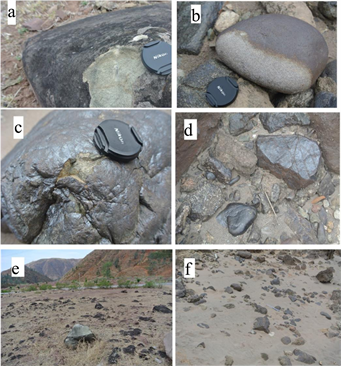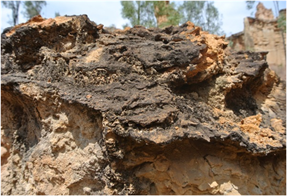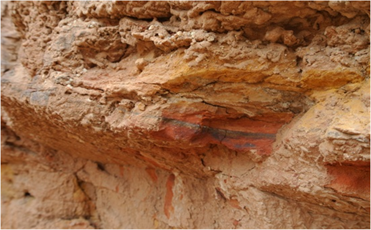Geographical Science Research
Vol.
08
No.
03
(
2019
), Article ID:
31592
,
11
pages
10.12677/GSER.2019.83028
Research Status and Prospect of Rock Varnish
Weikang Li, Huai Su*, Yuhan Pan
School of Tourism and Geographical Sciences, Yunnan Normal University, Kunming Yunnan

Received: July 15th, 2019; accepted: July 30th, 2019; published: August 6th, 2019

ABSTRACT
Rock varnish is a common dark brown material covering bare rock surface in arid and semi-arid areas. More than 200 years ago, scholars began to pay attention to this geological body. After a long-term study by scholars at home and abroad, there is no much controversy about the material source and composition of rock varnish in academic circles. The significance of environmental change indicators of rock varnish has achieved rich results, especially the environmental change indicators of micro-stratification of rock varnish. Although physical-chemical and biogeochemical Genesis models have been established for the formation of rock varnish, there are still disputes about the formation of rock varnish due to lack of definite evidence. Generally speaking, the current research on rock varnish is limited to modern geographical environment. There has never been any report on rock varnish formed in geological history period (i.e. rock varnish in strata). The “rock varnish” found in Yuanmou dry-hot valley and soil forest strata in Yunnan may become a new direction of domestic research on rock varnish. In view of the global spatial distribution of hot spots in rock varnish research, it may indicate an arid geographical environment. Varnish in Yuanmou dry-hot valley and soil-forest strata is likely to be important evidence to reveal the evolution history of Jinsha River dry-hot valley, which deserves our further study.
Keywords:Rock Varnish, Research Status, Dry-Hot Valley of the Jinsha River, Evolution History
岩漆研究现状与展望
李伟康,苏怀*,潘钰涵
云南师范大学旅游与地理科学学院,云南 昆明

收稿日期:2019年7月15日;录用日期:2019年7月30日;发布日期:2019年8月6日

摘 要
岩漆是干旱和半干旱地区常见的覆盖在裸露岩石表层的深褐色物质,200多年前就有学者开始关注这种地质体。经过国内外学者的长期研究,学术界对岩漆的物质来源和组成已无太多争议,岩漆的环境变化指示意义研究取得丰富成果,尤其是岩漆显微层理指示的环境变化成果颇丰。关于岩漆的形成原因,虽已形成物理化学成因和生物地球化学成因两大模型,但由于缺乏确切证据,岩漆的形成原因仍然存在争议。综合来看,目前人们对岩漆的研究均局限于现代地理环境中,对于地质历史时期形成的岩漆(即地层中的岩漆)从未有报道,而云南元谋干热河谷及土林地层中发现的“岩漆”或将成为国内岩漆研究的一个新方向,结合岩漆研究热点在全球的空间分布形式来看,岩漆可能指示了一种干旱的地理环境,而元谋干热河谷及土林地层中的岩漆,极有可能成为揭示金沙江干热河谷演化历史的重要证据,值得我们进一步研究。
关键词 :岩漆,研究现状,金沙江干热河谷,演化历史

Copyright © 2019 by authors and Hans Publishers Inc.
This work is licensed under the Creative Commons Attribution International License (CC BY).
http://creativecommons.org/licenses/by/4.0/


1. 引言
研究发现,岩漆是一层发育于缓慢风化的岩石表面且独立于其下伏基岩的黑色、红色或棕色薄层,厚度约为5 μm~600 μm [1] 。由于自然界中的岩漆广泛分布于沙漠戈壁的干旱和半干旱地区,早期的国外学者也将其称为沙漠岩漆(desert varnish) [2] 。岩漆在国外的研究历史已逾200年,在国内,虽在上世纪80年代到90年代有过一次研究热潮,但此后近20年左右的时间鲜有学者关注,直到近两年,才又有新的报道,特别是鲁安怀等近期在《PNAS》上发表了岩漆具有利用太阳能进行“光合作用”的观点 [3] 在学术界引起了高度关注。为广泛地让国内同行认识此地质体以更好地开展研究,特作此文以述之。
2. 国内外岩漆研究历史
在国外,岩漆最早由被称为“岩漆之父”的亚历山大·冯·洪堡(Alexander von Humboldt)于1812年在奥里科诺河(发源于南美洲委内瑞拉与巴西交界的帕里马山脉)首先观察到并对其进行了描述 [4] ,此后,一场关于岩漆物质来源的争论一直从19世纪持续到了20世纪中后期。伴随电子显微镜技术的不断成熟与应用,人们对于岩漆的物质来源基本上达成了共识,与此同时,岩漆的物质组成也逐渐变得清晰起来。之后,岩漆的研究重点转移到了岩漆成因上。但到目前为止,由于缺乏确切证据,人们对于岩漆的成因仍然存在争议。伴随岩漆成因理论的研究,有关岩漆的环境变化指示意义研究亦取得了一系列重要成果:最早,Bauman A.J. (1976)和Dorn et al. (1981)发现碱性增加有碍微生物对锰的氧化 [5] [6] ;此后,Dorn R.I. (1984)的电子探针分析报告指出:岩漆中的显微层理的Mn/Fe比值可能反映过去风沙碱度水平值的波动及可能的气候变化,而这一陆地环境变化的新指标可能在研究地貌、考古学、古气候及第四纪干旱环境研究方面有着重要意义 [7] 。直到1990年,Dorn R. I.才最终证实:不论是物理化学成因模型还是生物地球化学模型,大气环境中的碱度(pH值)都会影响岩漆形成过程中锰的富集 [8] 。之后,岩漆的显微层理及其环境变化指示意义逐渐成为研究热点并取得重要成果:Broecker W. S. (1994)的研究指出:美国西南部岩漆中富含锰的黑色微层理的形成,在时间上与北大西洋地区末次冰期中出现的Heinrich气候事件具有良好的对应关系 [9] ;Lui T., Broecker W. S. , Bell J. B.等(1999)也指出:岩漆中黑色微层理形成于相对湿润的气候环境,而橙色微层理则形成于相对干旱的气候 [10] ,但到此时,有关岩漆的成因仍然没有定论。近些年,随着对岩漆成因理论的进一步深入研究,国外研究者开始认识到,要用单一的某一种假说试图解释岩漆的成因是行不通的,岩漆的成因研究应该通过辩证分类、系统分析的方法找出不同类型岩漆的成因才是可行的,为此,Macholdt D. S. et al. (2017)通过采集来自北美洲、亚洲和非洲等地的大量岩漆样品,并通过对比分析其形成环境、微观结构和化学成分等,最终建议将岩漆分为I-V型 [11] ,其典型特征见表1。研究发现,气候差异和生物活性的不同可能是导致不同类型岩漆形态和矿物多样性的重要原因 [12] 。近两年,对于岩漆的研究范围甚至已扩展至南极洲的麦克默多干燥谷 [13] ,而DNA元基因组测序方法也开始用于研究在岩漆的形成过程中是否有微生物的作用,研究表明:虽然没有发现酶直接参与岩漆形成的证据,但也不能排除检测到的微生物的间接影响 [14] 。时至今日,关于岩漆的成因仍然没有一个确切说法,而争论的焦点实则在于岩漆形成过程中是否有微生物的作用,对此,相关研究仍在继续。
Table 1. Classification of rock lacquer types by structure and chemical composition [11]
表1. 按结构和化学成分对岩漆类型的分类 [11]
国内最早研究岩漆的是朱显谟,他提出岩漆与原始土壤形成有关,并将岩漆的形成作为原始土壤形成的第一个时期,另外,他也从外观上对岩漆进行了描述 [15] 。此后,张裕明等指出:岩漆是干旱地区多种地质作用的产物,而这其中受气候的影响最大 [16] 。后来的研究还发现,岩漆作为测定年龄及古环境、古气候的指示剂在许多领域的研究中具有巨大潜力 [17] ,甚至可以用来研究该地区千年尺度上的古气候变化 [18] 。近年来,国内对岩漆的研究也并不多,只有少数人对其矿物组成、元素组成、微结构特征及其类型与气候之间的关系等方面还有持续关注 [12] [19] 。
3. 岩漆的物质来源及组成
有关岩漆物质来源的争论,从岩漆最早发现时起就开始了。1812年,亚历山大·冯·洪堡(Alexander von Humboldt)首先观察到岩漆并对其进行描述时曾提出了岩漆的物质来源可能不是基岩,而是来自外界的“加积假说” [4] 。对此,很多学者并不赞同,他们一致认为岩漆是风化残留的基岩矿物质形成的,也就是说岩漆来源于岩石本身 [1] [2] [20] - [32] ,由于当时缺少诸如电子显微镜之类的观测技术手段,岩漆物质来源的争论便一直从19世纪持续到了20世纪中后期。后来,随着电子显微镜技术的不断成熟与应用,人们通过电子显微镜清楚观察到岩漆层与下伏基岩之间是有明显分界的 [33] [34] ,而并非处于渐变融合的状态,以此证实了亚历山大·冯·洪堡(Alexander von Humboldt)的推测,确定了岩漆物质并非来自基岩。此后,随着反向散射、高分辨率传输电子显微等技术的发展使用,人们对于沙漠岩漆的物质来源基本上达成了共识:岩漆是风成沉积物(aeolian deposit) [35] - [42] 。
关于岩漆的物质组成,早期研究表明:岩漆成分主要是一些结晶度较低的Mn和Fe的氧化物及粘土矿物,其中被认为是由风成沉积形成的层状硅酸盐粘土矿物占到了70%,另外还有一些微量元素和稀有元素组成 [43] 。通过岩漆样品的磁化率测定表明:赤铁矿是主要的磁性矿物 [44] 。后来的大量研究发现,岩漆所含主要元素为:Si、Ca、Al、Fe、Mg、Mn等,其对应的主要氧化物分别为:SiO2、CaO、Al2O3、Fe2O3、MgO、MnO2 [45] 。虽然,从目前岩漆分类的有关成果来看,不同类型岩漆的某些矿物和元素在含量上确实存在一定差异,这些差异或许与气候及生物活性不同有关 [11] ,但对于岩漆的主要矿物和元素种类构成,学术界目前已无太多争议。
4. 岩漆的形成原因
由于缺乏确切证据,岩漆的成因到目前为止仍然没有定论,但总结起来,最为人们所接受的主要有四种假说:
1) 锰相对铁的非生物增强循环沉积假说 [46] [47] ;此机制阐述的主要是岩漆形成中铁与锰的迁移规律,岩漆层是一个铁、锰氧化物富集的层次,岩漆中,铁、锰的比率比下层岩石大60倍,锰的富集是由于溶液pH造成,酸溶液循环溶解锰而不溶解铁,锰矿物与粘土矿物胶结,因此,该假说适用于气候相对湿润的环境,也就是大气环境中的碱度(pH值)较低的环境。2) 岩生生物及其残留有机物混合聚积沉积假说 [48] - [55] ;该假是基于岩漆层中发现有有机物残留物(例如孢子,多糖,氧化物,腐殖质)而提出的,这些有机残留物在粘合岩漆、浓缩锰铁矿物中起到了重要作用。3) 细菌-硅酸盐作用沉积假说 [56] [57] ;该假说仅适用于硅酸盐岩表明形成的岩漆,硅酸盐通过细菌作用,使pH升高,二氧化硅溶解成凝胶,结合粘土碎屑矿物、有机物和气溶胶形成沙漠岩漆。4) 细菌–粘土相互作用多成因沉积假说 [39] [58] [59] [60] ;该假说认为岩漆的形成是细菌作用下的氧化作用和锰、铁的浓缩富集并最终与粘土胶结沉淀,所以细菌的存在是该假说适用的必要条件,但研究发现,在岩漆的横截面中很少发现细菌 [59] ,所以该假说的普适性遭质疑。
以上四种假说又可以总结为没有微生物参与的物理化学成因模型和有微生物参与的生物地球化学模型。
4.1. 岩漆形成的物理化学成因模型
物理化学成因模型是基于许多岩漆下伏母岩不含锰的事实而提出的,该模型认为岩漆是在干旱碱性条件下,空中物质在岩石表面以物理化学方式沉淀而成 [61] [62] ,这也是目前较为人们公认和使用的机制,具体形成过程如图1所示:
1) 在裸露的岩石表面,灰尘被风吹进微型“盆地” (图1(A));
2) 在雨露或小雨事件之后,形成pH为8的溶液,在这种pH条件下,Mn和稀土元素变成了可移动的游离态,由于Fe的氧化速率非常快,任何溶解的Fe都会在表面氧化,因此在外层形成铁粘土矿物的混合层,Mn的氧化速率比Fe要低得多,这使得Mn能够留在溶液中并进行运动,溶解的锰可以通过之前积累的多孔沉积物向下渗透并吸附到粘土矿物中,积累的深度可能是由pH值变化,湿度限制,干燥时间,甚至是随时间减少的孔隙率决定的,在此过程中,从粘土矿物中滤出的稀土元素被吸附在锰氧化物上(图1(B));
3) 一旦溶液经过强烈蒸发过程干燥,风蚀(也许是吹砂/粉砂)去除上部,便露出主要包含硅、铝和铁的弱胶结的沉积物,在此过程中,大部分Ca也流失掉了,但由于Mn是沉积在一定深度而不易被侵蚀,因此就在底部形成了富锰层(图1(C),图1(D))。
4) 这一增量过程的重复发生最终形成岩漆。

Figure 1. Sketch map of physical and chemical genetic model of rock varnish [61] [62]
图1. 岩漆的物理化学成因模型示意图 [61] [62]
4.2. 岩漆形成的生物地球化学成因模型
1981年,R. I. Dorn和T. M. Oberlanger通过电子显微镜扫描和X射线对沙漠岩漆进行研究指出:自然环境中的沙漠岩漆和非沙漠环境下形成的富锰型岩漆似乎是微生物活动的产物 [6] ,1982年,他们正式提出了岩漆的生物地球化学模型,认为富锰型岩漆是生物地球化学作用的外壳,是能够氧化锰的混合营养型微生物作用的产物,这些微生物存在于大多数环境中,特别是干旱和半干旱地区的适度潮湿的岩石表面,兼可利用有机和(或)无机营养源。环境中的锰一旦被这些微生物氧化,就胶结周围的粘土胶粒,而这些粘土胶粒又反过来对锰起到了屏蔽作用,使之免受周围环境的影响而散失,这样,由被微生物氧化了的锰所胶结的粘土矿物就在岩石表面逐渐增生并最终形成了富锰型岩漆,他们还通过实验验证了上述生物地球化学模型,并通过人工实验增殖出能够氧化锰的混合营养型微生物,在贫营养物的pH值近中性的介质条件下,在刚破碎的新鲜岩石表面形成了富锰型岩漆,其微形态特征和矿物组成与天然的岩漆类似,并指出岩漆形成的pH值范围为中性或近中性的7.5~8 [63] 。对于该模型,最新的研究通过利用DNA元基因组测序技术对岩漆及其周围的土壤样品中的微生物进行对比研究发现:虽然没有发现酶直接参与岩漆形成的证据,但底物碱化和蓝藻通过碳浓缩机制等潜在的过程可能会使得局部pH值发生改变,并进一步影响尘衍生风化溶液中锰氧化物的沉淀富集,并且由于蓝细菌中含有锰,蓝细菌化石化也能间接富集锰,因此,微生物对I型岩漆形成的这种间接贡献可能是相关的,因此应进一步研究 [14] 。
5. 岩漆的全球分布及其可能指示的干旱地理环境
有关岩漆的研究在国内外一直以来都是热点,而研究热点地区(图2) [11] [18] [45] [64] [65] [66] 大都为降水量较少的干旱、半干旱地区,其中绝大部分为沙漠,降水极少。再从岩漆成因看,无论是岩漆形成的物理化学成因模型还是生物地球化学成因模型,岩漆形成的pH值范围都是中性或近中性的7.5~8,而这一pH值所反映出的也是一种少降水的干旱环境。综上所述,岩漆很有可能指示了一种干旱的地理环境。

Figure 2. Rock varnish of the hot spot research area of the lacquer [11] [18] [45] [64] [65] [66]
图2. 世界岩漆热点研究地区示意图 [11] [18] [45] [64] [65] [66]
6. 结论与展望
6.1. 结论
从1812年亚历山大·冯·洪堡(Alexander von Humboldt)最初发现并开始关注岩漆这种地质体开始至今,有关其物质来源、物质组成、形成原因及其显微层理与环境变化的关系等一系列问题的研究取得了丰富成果,特别是随着研究手段的日益进步,研究范围的不断扩大,关于岩漆研究的新成果层出不穷,岩漆分类亦取得新进展。值得一提的是,关于火星上岩漆的发现可能与火星生命相关的研究成果不断报道 [42] [67] [68] ,更加凸显出了岩漆研究的重要意义。综上所述,对岩漆的研究现状作如下总结:
1) 从国内外对岩漆的研究历史来看,岩漆的研究始于国外,国外岩漆研究成果也远多于国内,且就目前来看,国内对于岩漆的研究关注度不高,只有少数学者在持续关注,因此,提高国内学者对于岩漆的关注度并加强对其研究十分必要;
2) 关于岩漆的物质来源和物质组成这两个问题的研究过程虽然曲折,但目前学术界对此已无太多争议,但不同类型岩漆由于受气候和生物活性的不同等因素的影响,其物质组成从含量上来说可能存在一定差异;
3) 关于岩漆成因的研究经历了一个十分漫长的过程。目前虽已取得丰富的成果,并且也形成了较为普遍认可的理论模型,但对于岩漆形成是否有生物作用过程这一问题仍然争论不休,岩漆的成因也无统一定论。不过相关研究仍在继续,岩漆分类的研究也有新成果,相信这对于科学解释岩漆的形成原因又更近了一步;
4) 岩漆与环境变化之间的关系研究一度成为热点,尤其是岩漆显微层理与环境变化之间的关系研究受到了学术界的广泛关注,可喜的是,对此问题的研究,国内外均取得了一系列的丰富成果;
5) 从全球岩漆研究热点地区的空间分布与降水量之间的关系来看,岩漆似乎指示了一种干旱的自然环境,而岩漆成因的两大理论似乎也支持这种猜想;
6) 最新的研究结果表明:广泛分布的半导体矿物涂层(岩漆/Rock varnish)的太阳光响应和光电流产生能够在地球表面的生物地球化学过程中发挥重要作用。应注意,富锰型岩漆中主要含锰矿物的价带电位,例如双钠长石,比H2O/O2的氧化还原电位更为正,这表明水对氧的光催化氧化可能发生在地气圈的最顶层。此外,与其它半导体类似的双纳氏体导带中的光电子能为铁、锰等元素的还原提供驱动力,并能从NADP+中再生NADPH,为细菌代谢提供新的能量形式。取之不尽用之不竭的电子供体(如水、有机物、还原离子)的本质可以完成这些电子传递链,并产生连续的氧化还原化学,其中半导体矿物涂层是至关重要的桥梁。总的来说,这些涂层的太阳能收集和光电转换特性为利用太阳能从著名的有机世界到矿物半导体世界铺平了道路 [3] 。
6.2. 展望
随着岩漆研究的不断深入,对岩漆的关注甚至到了南极洲和火星。但从未有学者关注过地层中的“岩漆”,也就是地质历史时期形成的岩漆被保留在了地层之中。笔者在野外考察时发现,在云南楚雄元谋干热河谷中分布有大量岩漆(图3),从海拔928米的元谋江边乡到海拔2114米的元谋东山顶皆有分布,同时,在元谋土林铁质胶结层表层还发现了正在形成的岩漆(图4)以及元谋土林地层中铁质胶结层表层的“岩漆” (图5)。无独有偶,国外学者在沙特阿拉伯西南部的瓦伊德砂岩(Wajid Sandstone)中也发现了类似于土林地层中的铁质胶结层(ferruginous cement) (图6),并且对该胶结层单体(lower red unit “LRU”)的研

Figure 3. Rock varnish in dry-hot valley of Yuanmou
图3. 元谋干热河谷中的岩漆

Figure 4. “Rock varnish” in the surface of ferruginous cement layer in Yuanmou soil forest
图4. 元谋土林铁质胶结层表层正在形成的“岩漆”

Figure 5. “Rock varnish” in the surface of ferruginous cement layer in Yuanmou soil forest
图5. 元谋土林地层中铁质胶结层表层“岩漆”

Figure 6. Ferruginous cement in Waid sandstone, southwestern Saudi Arabia
图6. 沙特阿拉伯西南部的瓦伊德砂岩中的铁质胶结层
究表明:由于“LRU”单元中赤铁矿物质的存在,它的起源被认为是由于氧化、溶解和从交替的含铁层的铁质物质中析出而形成的 [69] ,而这一过程与目前被普遍认可的岩漆(rock varnish)的形成过程十分类似,并且其所含赤铁矿也与岩漆的矿物成分类似,这似乎能够再次说明:岩漆作为一种干旱气候环境的产物,极有可能在地质历史时期就曾出现过。因此,对于元谋土林地层铁质胶结层表层“岩漆”的进一步研究,对于揭示金沙江干热河谷的演化历史或具有重要意义。
基金项目
国家自然科学基金资助项目,项目号(41762014)。
文章引用
李伟康,苏 怀,潘钰涵. 岩漆研究现状与展望
Research Status and Prospect of Rock Varnish[J]. 地理科学研究, 2019, 08(03): 264-274. https://doi.org/10.12677/GSER.2019.83028
参考文献
- 1. Engel, C.G. and Sharp, R.P. (1958) Chemical Data on Desert Varnish. Geological Society of America Bulletin, 69, 487-518. https://doi.org/10.1130/0016-7606(1958)69[487:CDODV]2.0.CO;2
- 2. Hunt, C.B. (1954) Desert Var-nish. Science, 120, 183-184. https://doi.org/10.1126/science.120.3109.183
- 3. Lu, A., Li, Y., Ding, H., et al. (2019) Photoelectric Conversion on Earth’s Surface via Widespread Fe- and Mn-Mineral Coatings. Proceedings of the National Academy of Sciences of the United States of America, 116, 9741-9746. https://doi.org/10.1073/pnas.1902473116
- 4. Alexander, V.H., Aime, B. and Ross, T. (1907) Personal Narrative of Travels to the Equinoctial Regions of America during the Years 1799-1804. George Bell & Sons, London. https://doi.org/10.5962/bhl.title.23548
- 5. Bauman, A.J. (1976) Desert Varnish and Marine Ferromanganese Oxide Nodules: Congeneric Phenomena. Nature, 259, 387-388. https://doi.org/10.1038/259387a0
- 6. Dorn, R.I. and Oberlander, T.M. (1981) Microbial Origin of Desert Varnish. Science, 213, 1245-1247. https://doi.org/10.1126/science.213.4513.1245
- 7. Dorn, R.I. (1984) Cause and Implications of Rock Varnish Microchemical Laminations. Nature, 310, 767-770. https://doi.org/10.1038/310767a0
- 8. Dorn, R.I. (1990) Quaternary Alkalinity Fluctuations Recorded in Rock Varnish Microlaminations on Western U.S.A. Volcanics. Palaeogeography, Palaeoclimatology, Palaeoecology, 76, 291-310. https://doi.org/10.1016/0031-0182(90)90117-P
- 9. Broecker, W.S. (1994) Massive Iceberg Discharges as Trig-gers for Global Climate Change. Nature, 372, 421-424. https://doi.org/10.1038/372421a0
- 10. Lui, T., Broecker, W.S., Bell, J.B. and Mandeville, C.W. (1999) Terminal Pleisrocene Wet Event Recorded in Rock Varnish from the Las Valley, Southern Nevada. Palaeogeography, Palaeo-climatology, Palaeoecology, 161,423-433.
- 11. Macholdt, D.S., Jochum, K.P., Pöhlker, C., et al. (2017) Characteri-zation and Differentiation of Rock Varnish Types from Different Environments by Microanalytical Techniques. Chemical Geology, 459, 91-118. https://doi.org/10.1016/j.chemgeo.2017.04.009
- 12. Xu, X.-M., Li, Y., Li, Y., et al. (2017) Spectral Characteristics of Rock Varnish from Arid and Humid Regions in China. Bulletin of Mineralogy Petrology & Geochemistry, 36, 299-307.
- 13. Zerboni, A. and Guglielmin, M. (2017) Dust Input in the Formation of Rock Varnish from the Dry Val-leys (Antarctica). American Geophysical Union.
- 14. Langyona, N., Maier, S., Macholdt, D.S., et al. (2018) Insights into Microbial Involvement in Desert Varnish Formation Retrieved from Metagenomic Analysis. Environmental Mi-crobiology Reports, 10, 264-271. https://doi.org/10.1111/1758-2229.12634
- 15. 朱显谟. 论原始土壤的成土过程[J]. 中国科学B辑, 1983, 3(10): 920-925.
- 16. 张裕明, 柳覃卓, 李树伟. 中国西部甘新边界地区岩漆阳离子比率测年曲线的建立及其应用[J]. 地震地质, 1990, 12(3): 251-261.
- 17. 尹玉军, 陈静生. 一种利用岩漆测定年龄和研究古气候的新方法[J]. 地球科学进展, 1991, 6(2): 75-78.
- 18. 周本刚, 柳覃卓, 张裕明. 新疆北天山地区岩漆显微层理及其古气候意义[J]. 科学通报, 1999, 44(13): 1445-1448.
- 19. Xu, X., Ding, H., Li, Y., et al. (2018) Mineralogical Characteristics of Mn Coatings from Different Weathering Environments in China: Clues on Their Formation. Mineralogy and Petrology, 112, 671-683. https://doi.org/10.1007/s00710-018-0564-0
- 20. Bard, J.C., Asaro, F. and Heizer, R.F. (2010) Perspectives on the Dating of Prehistoric Great Basin Petroglyphs by Neutron Activation Analysis. Archaeometry, 20, 85-88. https://doi.org/10.1111/j.1475-4754.1978.tb00217.x
- 21. Birot, P. (1969) The Cycle of Erosion in Different Cli-mates. University of California Press, Berkeley, CA.
- 22. Holmes, A. (1965) Principles of Physical Geology. Ronald Press, New York.
- 23. Hume, W.F. (1925) Geology of Egypt. The Surface Features of Egypt, Their Determining Causes and Relation to Geologic Structure, Vol. 1. Government Press, Cairo.
- 24. Linck, G. (1901) ÜberdiedunkelenRinden der Gesteine der Wüste. Jenaische Zeitschrift für Naturwissenschaft, 35, 329-336.
- 25. Linck, G. (1928) ÜberSchutzrinden. Chemie der Erde, 4, 67-79.
- 26. Lucas, A. (1905) The Blackened Rocks of the Nile Cataracts and of the Egyptian Deserts. National Printing Department, Cairo.
- 27. Marcus, M.G. and Brazel, A.J. (1992) Summer Dust Storms in the Arizona Desert. In: Janelle, D.G., Ed., Geographical Snapshots of North America, Guilford Press, New York, 411-415.
- 28. Merrill, G.P. (1898) Desert Varnish. Bulletin of the United States Geological and Geographical Survey, 150, 389-391.
- 29. Peel, R.F. (1960) Some Aspects of Desert Geomorphology. Geography, 45, 241-262.
- 30. Walther, J. (1891) Die Denudation in der Wüste. Akademi der Wissenschaften: Mathematischk-Physicalische Klasse. Abhandlungen, 16, 435-461.
- 31. Wilhelmy, H. (1964) Cavernous Rock Surfaces in Semi-Arid and Arid Climates. Pakistan Geographical Review, 19, 8-13.
- 32. Woolnough, W.G. (1930) The Influence of Climate and Topography in the Formation and Distribution of Products of Weathering. Geological Magazine, 67, 123-132. https://doi.org/10.1017/S0016756800099015
- 33. Dorn, R.I., Krinsley, D.H. and Ditto, J. (2012) Alexander von Humbodlt’s Initiation of Rock Coating Research. Geology, 12, 1-12.
- 34. Langworthy, K.A., Krinsley, D.H. and Dorn, R.I. (2010) High Resolution Transmission Electron Microscopy Evaluation of Silica Glaze Reveals New Textures. Earth Surface Processes & Landforms, 35, 1615-1620. https://doi.org/10.1002/esp.2061
- 35. Liu, T. and Broecker, W.S. (2000) How Fast Does Rock Varnish Grow? Geology, 28, 183-186. 2.0.CO;2>https://doi.org/10.1130/0091-7613(2000)28<183:HFDRVG>2.0.CO;2
- 36. Liu, T. and Broecker, W.S. (2008) Rock Varnish Evidence for Latest Pleistocene Millennial-Scale Wet Events in the Drylands of Western United States. Geology, 36, 403-406. https://doi.org/10.1130/G24573A.1
- 37. Perry, R.S. and Adams, J.B. (1978) Desert Varnish: Evidence for Cyclic Deposition of Manganese. Nature, 276, 489-491. https://doi.org/10.1038/276489a0
- 38. Dorn, R.I. (2009) Desert Rock Coatings. In: Parsons, A.J. and Abrahams, A.D., Eds., Geomorphology of Desert Environments, Springer, Dordrecht, 153-186. https://doi.org/10.1007/978-1-4020-5719-9_7
- 39. Krinsley, D., Dorn, R. and Anderson, S. (1990) Factors that May Interfere with the Dating of Rock Varnish. Physical Geography, 11, 97-119. https://doi.org/10.1080/02723646.1990.10642396
- 40. Krinsley, D. (1998) Models of Rock Varnish Formation Constrained by High Resolution Transmission Electron Microscopy. Sedimentology, 45, 711-725. https://doi.org/10.1046/j.1365-3091.1998.00172.x
- 41. Krinsley, D., Dorn, R. and Tovey, N.K. (1995) Nanometer-Scale Layering in Rock Varnish: Implications for Genesis and Paleoenvironmental Interpretation. The Journal of Geology, 103, 106-113. https://doi.org/10.1086/629726
- 42. Krinsley, D. and Rusk, B.G. (2000) Bacterial Presence in Layered Rock Varnish-Possible Mars Analog? International Conference on Mars Polar Science & Exploration, Reykjavik, Iceland, 21-25 August 2000, 98.
- 43. Potter, R.M. and Rossman, G.R. (1979) The Manganese- and Iron-Oxide Mineralogy of Desert Varnish. Chemical Geology, 25, 79-94. https://doi.org/10.1016/0009-2541(79)90085-8
- 44. Thiagarajan, N. and Lee, C.T.A. (2004) Trace-Element Evidence for the Origin of Desert Varnish by Direct Aqueous Atmospheric Deposition. Earth and Planetary Science Letters, 224, 131-141. https://doi.org/10.1016/j.epsl.2004.04.038
- 45. Sarmast, M., Farpoor, M.H. and Esfandiarpour Boroujeni, I. (2017) Soil and Desert Varnish Development as Indicators of Landform Evolution in Central Iranian Deserts. Catena, 149, 98-109. https://doi.org/10.1016/j.catena.2016.09.003
- 46. Hooke, R.L., Yang, H. and Weiblen, P.W. (1969) Desert Varnish: An Electron Probe Study. The Journal of Geology, 77, 275-288. https://doi.org/10.1086/627435
- 47. Smith, B.J. and Whalley, W.B. (1988) A Note on the Characteristics and Possible Origins of Desert Varnishes from Southeast Morocco. Earth Surface Processes and Landforms, 13, 251-258. https://doi.org/10.1002/esp.3290130306
- 48. Allen, C.C., Probst, L.W., Flood, B.E., et al. (2004) Meridiani Planum Hematite Deposit and the Search for Evidence of Life on Mars—Iron Mineralization of Microorganisms in Rock Varnish. Icarus, 171, 20-30. https://doi.org/10.1016/j.icarus.2004.04.015
- 49. Gorbushina, A.A. (2003) Microcolonial Fungi: Survival Potential of Terrestrial Vegetative Structures. Astrobiology, 3, 543-554. https://doi.org/10.1089/153110703322610636
- 50. Krumbein, W.E. (1968) Über den Einfluß der Mikroflora auf die exogene Dynamik (Verwitterung und Krustenbildung). Geologische Rundschau, 58, 333-363. https://doi.org/10.1007/BF01820710
- 51. Kuhlman, K.R., Fusco, W.G., La Duc, M.T., et al. (2006) Diversity of Microorganisms within Rock Varnish in the Whipple Mountains, California. Applied and Environmental Microbiology, 72, 1708-1715. https://doi.org/10.1128/AEM.72.2.1708-1715.2006
- 52. Parchert, K.J., Spilde, M.N., Porras-Alfaro, A., et al. (2012) Fungal Communities Associated with Rock Varnish in Black Canyon, New Mexico: Casual Inhabitants or Essential Partners? Geomicrobiology Journal, 29, 752-766. https://doi.org/10.1080/01490451.2011.619636
- 53. Perry, R.S. and Kolb, V.M. (2004) Biological and Organic Constituent of Desert Varnish: Review and New Hypotheses. Proceedings of Instruments, Methods, and Missions for Astrobiology, 5163, 202-217. https://doi.org/10.1117/12.509695
- 54. Staley, J.T., Jackson, M.J., Palmer, F.E., et al. (1983) Desert Varnish Coatings and Microcolonial Fungi on Rocks of the Gibson and Great Victoria Desert, Australia. AGSO Journal of Australian Geology & Geophysics, 8, 83-87.
- 55. White, C.H. (1924) Desert Varnish. American Journal of Science, 7, 413-420. https://doi.org/10.2475/ajs.s5-7.41.413
- 56. Perry, R.S., Lynne, B.Y., Sephton, M.A., et al. (2006) Baking Black Opal in the Desert Sun: The Importance of Silica in Desert Varnish. Geology, 34, e122-e123.
- 57. Perry, R.S., Lynne, B.Y., Sephton, M.A., et al. (2006) Baking Black Opal in the Desert Sun: The Importance of Silica in Desert Varnish. Geology, 34, 537-540.
- 58. Dorn, R.I. (1998) Rock Coatings. Elsevier, Amsterdam.
- 59. Dorn, R.I. and Krinsley, D. (2011) Spatial, Temporal and Geographic Considerations of the Problem of Rock Varnish Diagenesis. Geomorphology, 130, 91-99. https://doi.org/10.1016/j.geomorph.2011.02.002
- 60. Dorn, R.I., Krinsley, D.H., Liu, T., et al. (1992) Manganese-Rich Rock Varnish Does Occur in Antarctica. Chemical Geology, 99, 289-298. https://doi.org/10.1016/0009-2541(92)90182-5
- 61. Potter, R.M. and Rossman, G.R. (1977) Desert Varnish: The Importance of Clay Minerals. Science, 196, 1446-1448. https://doi.org/10.1126/science.196.4297.1446
- 62. Elvidge, C.D. and Moore, C.B. (1980) Restoration of Petroglyphs with Artificial Desert Varnish. Studies in Conservation, 25, 108-117. https://doi.org/10.1179/sic.1980.25.3.108
- 63. Dorn, R.I. and Oberlander, T.M. (1982) Rock Varnish. Progress in Physical Geography: Earth and Environment, 6, 317-367. https://doi.org/10.1177/030913338200600301
- 64. Liu, T. and Broecker, W.S. (2013) Millennial-Scale Varnish Microlamination Dating of late Pleistocene Geomorphic Features in the Drylands of Western USA. Geomorphology, 187, 38-60. https://doi.org/10.1016/j.geomorph.2012.12.034
- 65. Goldsmith, Y., Stein, M. and Enzel, Y. (2014) From Dust to Varnish: Geochemical Constraints on Rock Varnish Formation in the Negev Desert, Israel. Geochimica et Cosmochimica Acta, 126, 97-111. https://doi.org/10.1016/j.gca.2013.10.040
- 66. Macholdt, D.S., Jochum, K.P., Pöhlker, C., et al. (2015) Microanalytical Methods for in Situ High-Resolution Analysis of Rock Varnish at the Micrometer to Nanometer Scale. Chemical Geology, 411, 57-68. https://doi.org/10.1016/j.chemgeo.2015.06.023
- 67. Mancinelli, R.L., Bishop, J.L. and De, S. (2002) Magnetite in Desert Varnish and Applications to Rock Varnish on Mars. 2002 Lunar & Planetary Science Conference, League City, TX, 11-15 March 2002.
- 68. Ward, J.G., Kirkland, L.E., Keller, D., et al. (2001) Terrestrial Rock Varnish: A Key to Understanding the Surface Composition of Mars. 2001 Lunar & Planetary Science Conference, Houston, TX, 12-16 March 2001.
- 69. El Aal, A.A. and Nabawy, B.S. (2017) Implications of Increasing the Ferruginous Cement on the Physical and Mechanical Properties of the Cambro-Ordovician Wajid Sandstone in Southwest Saudi Arabia: Applications for Construction Purposes. Bulletin of Engineering Geology and the Environment, 78, 817-836. https://doi.org/10.1007/s10064-017-1115-3
NOTES
*通讯作者。
